

| Some notes on the bioluminescence of male Glow Worms in captivity |
| ................. | ||
| Bioluminescence produced by female Glow Worms is a well known phenomenon and one which was first scientifically described and written of many centuries ago. But even after hundreds of years, Glow Worm bioluminesence remains a much studied and talked about subject among those who have an interest and an enquiring mind. | ||
| ................. | ||
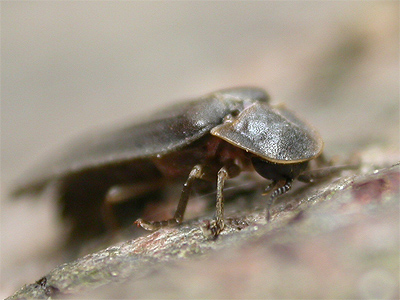 |
Larval bioluminescence also
continues to be the topic of many conversations regarding
Glow Worms and has also been well studied. We spent
several years ourselves, looking at larval
bioluminescence and soon concluded that any form of
comprehensive study, often throws up more questions than
it answers. We were accompanied in that study by Martin Dale, who co-authored two research reports on larval bioluminesence that we published in November 2015. However, both Martin and ourselves were equally fascinated by the male Glow Worm's ability to glow, a topic which (for some reason) still seems to divide the opinions of both Glow Worm enthusiasts and experts alike. There is no doubt that male Glow Worms do indeed produce short-lived, characteristic glows (flashes) in flight, but proving it has always been difficult and it was a challenge recently taken up by Martin. |
|
| ................. | ||
| A
brief introduction to male Glow Worm bioluminesence In the field and under dark conditions, Martin and ourselves had regularly recorded small, distinctly green flashes on numerous occasions, which we quickly concluded must come directly from males in flight. These flashes were always recorded low over vegetation and to rule out the possibility of an observers eyes playing tricks, only flashes recorded and claimed simultaneously by two observers were ever noted. |
||
| ................. |
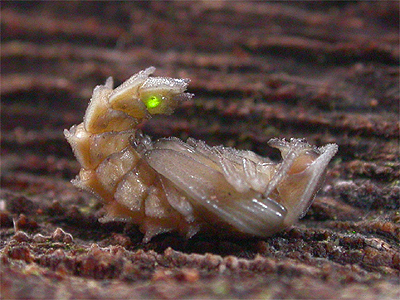 |
During a public Glow Worm
walk conducted by rangers from the Sherwood Forest
Visitor Centre a few years ago, the lead ranger and a
member of the public (who knew nothing of male
bioluminescence) both simultaneously saw the green flash
of a male. The bioluminescence produced by male Glow Worms is certainly very real, but its also very elusive. We eventually decided to prove to ourselves that males do glow and finally confirmed it when several males were potted up, after being attracted to an artificial lure and almost immediately observed them to be glowing dimly. Although we described it as being 'numerous', male bioluminescence is rarely observed in the field and it is very difficult to corroborate, even when the observers have great experience in astronomical observing and have excellent perception. The main reason for the corroboration difficulties are that the flash is typically very brief and can only be detected by the human eye when the male is flying close to the observer and just above eye-level. Plus, both observers also have to be looking in the same place. |
|
| Recent
studies and observations of the bioluminesence produced
by male Glow Worms in a captive environment The following text and photographs are the result of many hours of observational research by Martin Dale at his home in Nottingham. As already mentioned, Martin co-authored with us, the two publications listed at the bottom of this page, that were published as pdf files at the end of 2015. Martin's supplied text below, has only been lightly edited to retain the style of the opening paragraphs we have written as an introduction to his research results. The original photographs capturing the elusive male glow which Martin kindly sent to us, have only been cropped, then sharpened once using photo editing software. No photographs have been superimposed, or otherwise tampered with. |
||
| Some
notes on the bioluminescence of male Glow Worms in
captivity Entering my fifth year studying a captive colony of Glow Worms, all indications suggested that 2016 would produce a similar season of pupating and emerging adults to 2015 and right on cue, the first male pupa was found on the 10/05/16 - within days of last year's first. Two more male pupae soon appeared in the containers and by the end of the May, over 35 larvae had successfully pupated. This was over five times the number of pupae produced in the whole of 2015 season and many more pupae quickly followed. |
||
| .................................. | ||
| The first adult male
emerged on the 03/06/16 and having had such a large
number of male Glow Worms this season, it presented me
with the ideal opportunity to observe their behaviour as
a group, especially at dusk and around the time when
females would normally begin to glow. The opportunity was
also taken to attempt to photograph and study the males
elusive bioluminescent behaviour. As the larvae pupated, I immediately transferred them into a separate container to prevent any predation by the Snails still present with the remaining larvae. It is worth noting by the reader, that by this point it was becoming relatively easy to determine when individual larvae were about to pupate. The larvae of both sexes would enter a distinct period of pre-pupation, becoming dormant after the cesation of all hunting and feeding activity and often lying on their backs for up to seven days, before an eventually rapid pupation lasting only a few hours was completed. |
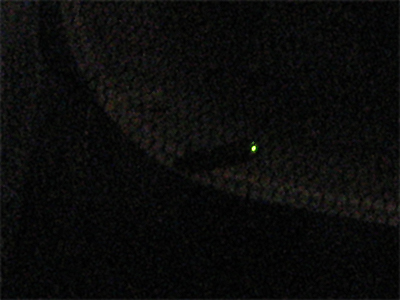 |
|
| ................. | ||
| Having
accumulated so many male pupae in one small container,
the first striking phenomenon I observed, was the
tendency of male pupae to noticeably glow at the
slightest disturbance. Witnessed during previous season's
research when largely dealing with individual pupae,
having a much larger number of male pupae showed how
significantly more likely it was that male pupae (rather
than female pupae) would glow when disturbed. A 'constellation' of sustained glows lasting over a minute or more, could be observed following the smallest of container vibration! This glowing was observed in all male pupae in the hours immediately after pupation and was recorded in at least 50% of the pupae, up to the point of adult emergence several weeks later. |
||
| ................. | ||
| As the males emerged and
the total count of adult males moved into double figures,
their activity and bioluminescent behaviour could be more
easily observed at dusk. Most notable was how they would
suddenly become active and agitated at a specific point
of dusk, having been largely dormant during daylight.
This activity usually started around the end of civil
twilight but about 10 to 15 minutes before nearby females
in another container would begin to glow. This was
observed on three separate occasions when the males would
crawl around in circles and quickly climb the container
walls with some opening their wings cases (Elytra)
briefly. Once on the rim of an open container, many
quickly flew off towards the window and elsewhere in the
room, the scene being reminiscent of when bats leave a
cave to hunt. Of particular interest during each evening's observation of this active phase, was the male Glow Worm's bioluminescent behaviour. This behaviour (under close observation night by night) fell into four distinctly different patterns. |
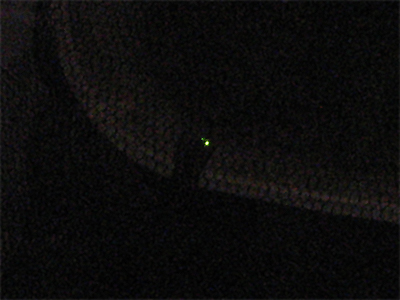 |
|
| ................. | ||
Several males were observed to produce periodic glows, similar to that produced by Glow Worm larvae when hunting. Clearly males could not be hunting for prey as adults, but could the glows be part of the same strategy to ward off predators? The observed male glows were less frequent than larval glows, but tended to be longer in duration - sometimes longer than a minute. I also noted that the intensity of the glow seemed to be slightly stronger in some subjects, than the average larval glows studied closely during previous research work. These periodic male glows were observed many times during three separate nights of observation, with approximately 15-20% of the males glowing in the container at some point during the active phase and prior to flight. |
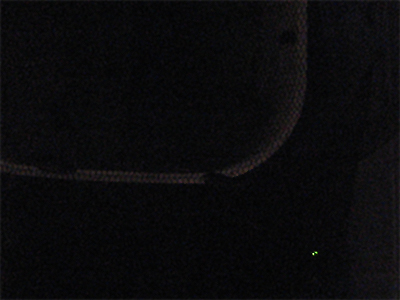 |
|
| ................. | ||
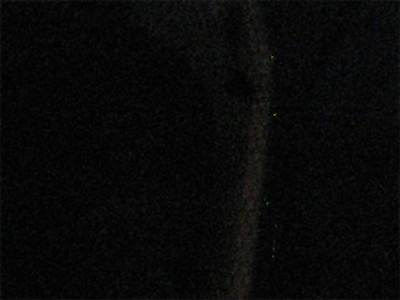 |
On two occasions, two
separate males were seen to issue much briefer
Firefly-like pulses, or flashes of bioluminescence when
being in close contact with other males. This phenomenon
has not yet seen to be repeated and further observations
will be necessary. A much more rarely observed bioluminescent phenomenon has been male Glow Worms glowing in flight. This has been seen and corroborated by two simultaneous observers at in field studies at Clipstone Old Quarter on several previous occasions. Also, as part of this study I have witnessed this behaviour three times here in my captive colony - once last year (2015) and twice over the ten days of close observation this year. Recorded here, the glow periods in flight were fleeting and difficult to time due to their sporadic and surprising nature. But on each occasion, they were unmistakable in origin in dark conditions, with one male recorded still glowing dimly for a few seconds after landing on a nearby surface. |
|
| ................. | ||
| These
fleeting glows in flight have proved to be impossible to
record without specialist video camera imaging, but
remain one of the most intriguing aspects of male Glow
Worm bioluminescent behaviour. Finally, just as in both the larval and pupal stages, the males here have been seen to glow responsively to disturbance, such as from handling. This seems to be the most commonly recorded bioluminescence in male Glow Worms and in the research colony here, over 70% of the males glowed when picked up or lightly restrained. In this case, what is of interest are those males that do not respond by glowing, suggesting that further research would be of value in determine whether these males have seemingly lost their ability to glow at some stage in there development. |
||
| Pendleton, T.A.
Pendleton, D.T. and Dale, M.G. "Some notes
and observations on the bioluminescence exhibited by the
larva of the Glow Worm (Lampyris noctiluca) in
captivity" www.eakringbirds.com; December 2012. Pendleton, T.A. Pendleton, D.T. and Dale, M. "The size variation and age ratios found within the larval population of the Glow Worm (Lampyris noctiluca) during Autumn Project 2: Phase 2. 2013" www.eakringbirds.com; Feb 2014. |
||